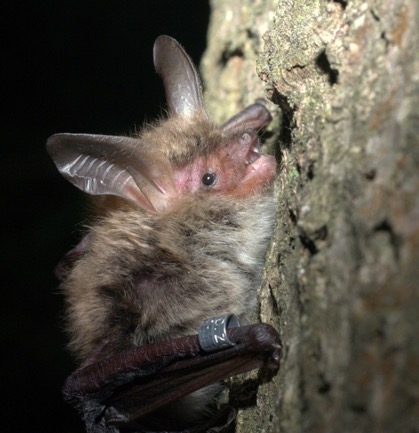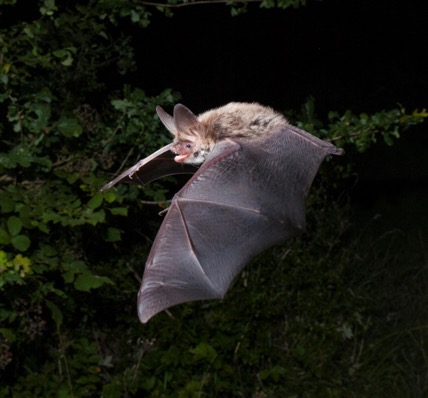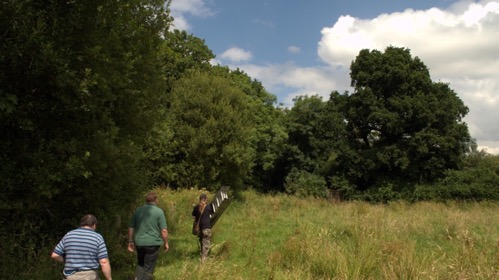
It is well known that bats are unique amongst mammals. Their ability to fly has allowed them to establish themselves in most continents and habitats, with the exception of Antarctica. Bats have also evolved a distinctive ability among land mammals to use echolocation as a tool for orientation. Both adaptations have allowed them to take advantage of an aerial nocturnal lifestyle and utilise a vast diversity of ecological niches. This diversity is reflected by a wide variety of roosting, feeding, and social behaviours, as well as a range of reproductive strategies. Due to their lifestyle, they are extremely hard to study and monitor – indeed, a review published in 2019, indicated that 57% of bat species have unknown population trends and almost a quarter of species are Data Deficient by the IUCN Red List (Frick et al., 2019). Conservationists, therefore, are continuously challenged to develop new techniques to better understand and protect bats.

The Bechstein’s bat is threatened by habitat loss and fragmentation. Photo: ©Henry Schofield
While the first human genome took more than 13 years to be fully sequenced and cost 3 billion US dollars, rapid advances in the field mean that these technologies are now a lot faster and cheaper. The Bat1K genome project intends to sequence the full genome of all bat species in order to uncover the secret of longer health-spans, flight, echolocation and disease resistance hidden in the bat genome. These molecular tools are also useful in the field of conservation genetics to better understand and protect wildlife and can be used to detect hybridisation, resolve taxonomic uncertainties and, most importantly, to assess the genetic health of rare species. Recent access to latest genetic techniques has also led to new opportunities to answer some of the issues we come across when studying and monitoring bat populations.
My association with Vincent Wildlife Trust began in 2015 when I started a PhD, co-funded by VWT, at Exeter University. The focus of my research was the Bechstein’s bat (Myotis bechsteinii), a species recognised as one of Europe’s most elusive bats. It is found primarily in ancient woodlands and colonies tend to roost in woodpecker-made cavities. The species was first recorded in Britain in 1837. This, however, was not followed by a deluge of records as they had only been recorded from 14 sites before 1989 (Stebbings, 1989). It was only when the Bat Conservation Trust Bechstein’s Bat Survey started in 2007 that we began to understand the habitat requirements of the species and its distribution in Britain.
The high level of legal protection for the species makes it essential to quantify population size and structure, detect changes and protect key habitats. In the case of elusive species, like the Bechstein’s bat, conventional approaches for monitoring cannot be applied. Indeed, the species echolocation calls are hard to differentiate from other Myotis species and roost count along with trapping are both particularly time consuming. The use of molecular techniques, however, can help elucidate some of these mysteries!
With the help of several bat groups, I managed to collect hundreds of DNA samples from all over southern Britain and western Europe. Then, I headed straight to the lab to do some genetic analysis on these samples. I found that the British population showed signs of isolation from the continental populations, meaning that there is probably very little movement occurring between Britain and the continent. This discovery could have led us to believe that British populations would be inbred, but this was not the case. In fact, inbreeding levels remained low throughout their range with the exception of a small isolated population found in Buckinghamshire (Wright et al., 2018a).

Members of Dorset Bat Group were among those who helped to collect hundreds of DNA samples Photo: ©Patrick Wright
For the case of Bechstein’s bats, population genetics alone can provide insight on major barriers, such as mountain ranges and seas. However, the structure and composition of most landscapes affect populations in a more complex way. The field of landscape genetics was introduced to fill in these gaps by providing a robust way to measure the relationship between gene flow and the species habitat. For the case of Bechstein’s bats, we found, unsurprisingly, that woodland fragmentation was an important factor influencing connectivity between different populations. This helped us understand why we found some separation between the northern and southern part of the species range in Britain. In this case, Salisbury Plain seems to be a major reason behind the break!
New opportunities for bat conservation may also arise from unexpected avenues. For example, forensic scientists often come up with new ways to study crime scenes. The link between bat conservation and crime scenes may not be obvious at first, but this all changed when I found out that age estimates of victims or suspects could be made from a bit of DNA. Imagine applying these methods to age bats – it could be ground breaking! Indeed, bats live substantially longer than other mammals of similar size and metabolic rate (Wilkinson & South, 2002) with certain species, such as Brandt’s bat (Myotis brandtii), recorded as surviving in the wild for more than 40 years (Gaisler et al., 2003). Any additional information on the age structure of a colony can provide insight on the health of the population. For example, a bat colony comprised of a majority of very old bats and few young bats may suggest that the colony is on the edge of collapse while the opposite would suggest a growing population. However, up until recently, any trustworthy estimate on the age of bats depended solely on long-term ringing studies. Using methods very similar to those deployed by forensic scientists, which involved identifying areas in the genome where levels of DNA methylation would increase or decrease with age, I published a novel method in 2018 to age Bechstein’s bats (Wright et al. 2018b). By providing information on the age structure of an entire colony from a single sampling session, our methods could facilitate prompt conservation action when required as we would not be dependent on any long-term ringing information.
One could argue that developing an ageing assay for such an elusive species, like the Bechstein’s bat, was very ambitious and that it may have been easier to develop this assay on a more common species. However, woodland species are in greater need of novel monitoring techniques. Still today, we have no information on the population trends of woodland bats in Britain and the few species trends available from the IUCN red list are solely inferred from the state of their habitat. With the use of molecular ageing techniques alongside other genetic measures, such as effective population size estimates, we have, for the first time, the tools to fill this data gap.

Bechstein’s bats, like many other woodland species, are difficult to monitor. Photo: ©Patrick Wright
There is still much to be discovered about the Bechstein’s bat. For example, we still know very little about their swarming behaviour and where they all go in winter. While the use of genetic techniques will not answer all our questions, it can however provide new insight on populations in order to better monitor and protect the species.
Dr Patrick Wright, VWT Senior Science and Research Officer
Article based on one originally produced for the Bat Conservation Trust
References
Frick, W.F., Kingston, T. & Flanders, J. (2019). A review of the major threats and challenges to global bat conservation. Annals of the New York Academy of Sciences.
Gaisler, J., Hanák, V., Hanzal, V. & Jarský, V. (2003). Results of bat banding in the Czech and Slovak Republics, 1948–2000. Vespertilio, 7: 3-61.
Stebbings, R. (1989). The Bechstein’s bat (Myotis bechsteinii) in Dorset and Britain 1800-1989. Proceedings of the Dorset Natural History and Archaeological Society, 110: 178-180.
Wilkinson, G.S. & South, J.M. (2002). Life history, ecology and longevity in bats. Aging Cell, 1(2): 124-131.
Wright, P., Hamilton, P., Schofield, H., Damant, C., Davidson-Watts, I., Glover, A.M. & Mathews, F. (2018a). Genetic structure and diversity of a rare woodland bat, Myotis bechsteinii: comparison of continental Europe and Britain. Conservation Genetics, 19(4): 777-787.
Wright, P.G., Mathews, F., Schofield, H., Morris, C., Burrage, J., Smith, A., Dempster, E. & Hamilton, P. B. (2018b). Application of a novel molecular method to age free‐living wild Bechstein’s bats. Molecular Ecology Resources, 18(6): 1374-1380.